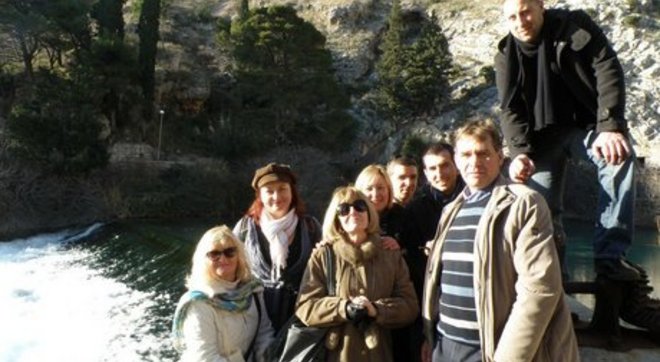Citizens and NGO’s send a message from Dubrovnik – Stop HEP’s devastation of Ombla!
in Komolac at the source of the river Ombla, the initiative Srđ is Ours, Green Action activists, in cooperation with the Heinrich Böll Stiftung, Right to the City (Pravo na grad), Eko Omblići and Green Sun (Zeleno sunce) supported the citizens of the settlement near Ombla in their fight against the construction of this harmful project.
Taking into account the example of HEPP Lešće on the river Dobra, which was built based on an old and faulty EIA, and now after its trial run, and a multi-million investment, citizens and the local government are questioning whether the investment brought more harm than good, we do not want even worse devastation for the river Ombla. We ask that the Croatian Government invalidate the EIA, because it was not done according to valid standards and laws, and to give up on building the high-rick and very harmful HEPP Ombla, said representatives of the initiatives, NGO’s and citizens.
“In the documentation of the HEPP Ombla it states that the power plant is not in a seismically unstable area, and that the dam and underground accumulation do not increase earthquake risk, however Dubrovnik lies in the most earthquake endangered region in Croatia”, said Marin Pavlović.
“On top of that, HEP does not inform the public thoroughly and in due time about the project and its risks, instead trying to expropriate owners of farmland next to the river and above the river’s source so they can begin building access roads, even though they do not have all the necessary permits”, said Ljubica Matović from Rožata.
“The construction of HEPP Ombla costs 152 million euro and is based on an old and faulty EIA. 35 environmental organizations all across Europe have raised their voices against the construction of this underground hydro-plant, and the European Commission has expressed concern because of the project”, said Enes Ćerimagić from Green Action. “It is incongruous that a government institution, such as HEP, abuses the expropriation mechanism so, working non-transparently, and pressuring the landowners.”
HEPP Ombla is illegal because the EIA for this project is 10 years old, but according to the valid Environmental Protection Law, EIAs older than two years cannot be used. On top of that, during the approval of the old EIA, the opinion of one of the committee members, who was vehemently against the project, was ignored and he was excluded from further activities of the committee.
Đuro Capor from the civil initiative Srđ is ours added: the Kukuriku coalition answered pre-election questions from citizens on their web-site and said: “concerning the fate of the HEPP Ompla project, the economic feasibility study as well as the EIA, have both recently shown that the project is neither economically rational, nor ecologically acceptable. We interpret the recent statements of the HDZ concerning the sale of so-called technical water from HEPP Ombla to Arabic states as a desire of the governing political parties to picture the HEPP Ombla project as economically feasible. The parties of the Kukuriku coalition do not support economically and ecologically questionable projects.”
HEPP Ombla is a technically risky and economically unfeasible project, which is concluded in the Economic Feasibility Study, which was done by independant consultants for the EBRD, in September 2011. The project can only be feasible if it is heavily financed from the state budget or if the price of electricity is increased several times. HEPP Ombla is feasible only if water is exported to the international market and the golf course on Srđ.
Jadranka Šimunović, representative of EKO OMBLIĆI and ZELENO SUNCE has reminded that the construction of HEPP Ombla would submerge the cave system of Vilina jama – Omlba, which has high biodiversity and is included in the nature protection plan as a part of Europe’s network of protected zones – Natura 2000. Several endangered species are found in the Ombla – Vilina jama system, including the čovječja ribica (Proteus anguinus), špiljska kozica (Troglocaris anophthalmus), and the only cavernous shell fish in the world (Congeria kusceri). Apart from the cavernous species, four kinds of storks are found only in the system: Horatia knorri, Lanzaia kusceri, Plagigeria nitida angelovi (freshwater cavernous snail) and Eukonenia pretneri.
